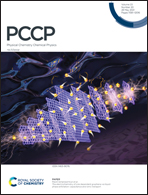Mechanism of chiral recognition by enantiomorphous cytosine crystals during enantiomer adsorption†
Abstract
The quest to understand why life exhibits chirality has been far from successful. In the terrestrial theory of chirality emergence in living matter, one of the main possible mechanisms is the chiral recognition of organic molecules by enantiomorphic crystals. In this work, we studied the ability of enantiomorphic cytosine crystals, obtained by Viedma ripening, for chiral recognition by enantiomers adsorption. For this, we used MD calculations, inverse gas chromatography, and adsorption from solutions. The difference between the isotherms of enantiomers was determined using a t-test. We found that cytosine crystals were capable of chiral recognition only when the adsorbate concentration on the surface was sufficient for lateral interactions leading to layer formation. In order to approximate adsorption isotherms, Langmuir, Freundlich, BET, and Fowler–Guggenheim equations were used. The difference in lateral interactions between menthol enantiomers during their adsorption from a solution in n-heptane was established. A mechanism of chiral recognition of the adsorbed substance by cytosine crystals was proposed. The conditions under which chiral recognition could proceed were determined. We observed that, upon adsorption from a solution, chiral recognition manifested itself at higher coverages than in MD simulations. This was caused by the competitive adsorption of the solvent. The results obtained show that adsorption on enantiomorphic crystals could be the source of the first minute enantiomeric excess, providing an opportunity to understand the origin of chiral imbalance.



 Please wait while we load your content...
Please wait while we load your content...